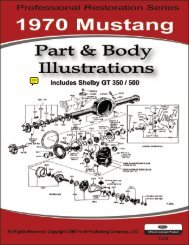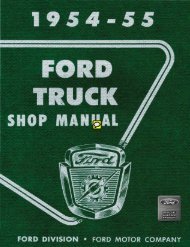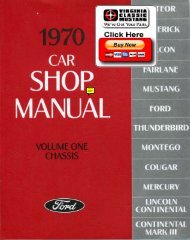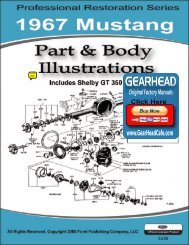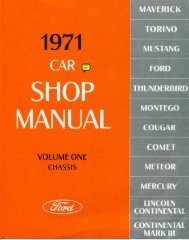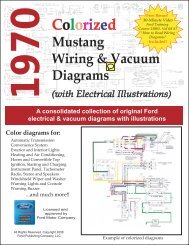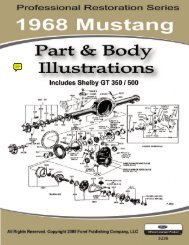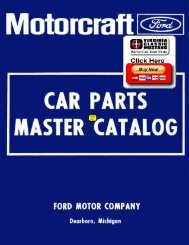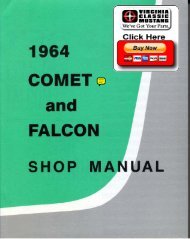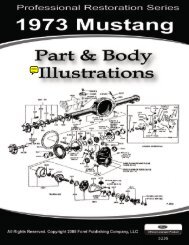DEMO - 1965 Ford Truck Shop Manual - ForelPublishing.com
DEMO - 1965 Ford Truck Shop Manual - ForelPublishing.com
DEMO - 1965 Ford Truck Shop Manual - ForelPublishing.com
Create successful ePaper yourself
Turn your PDF publications into a flip-book with our unique Google optimized e-Paper software.
2-10 GROUP 2-BRAKES<br />
in %2 inch of any rivet head, or when<br />
the lining has been soaked with oil<br />
or grease. If a worn lining is not replaced,<br />
the brake drum may be<strong>com</strong>e<br />
severely damaged. Always replace<br />
the primary and secondary brake<br />
shoe lining assemblies on both front<br />
or both rear brake assemblies at the<br />
same time.<br />
3. Before relining a brake shoe, inspect<br />
the shoe for distortion, cracks,<br />
or looseness between the rim and<br />
web. If one of these conditions exists,<br />
replace the shoe. Do not attempt<br />
to repair a damaged brake shoe.<br />
4. If the drum and linings are in<br />
good condition, install the wheel and<br />
drum. The condition of the drums<br />
and linings of the other three wheels<br />
will usually be about the same as that<br />
found at the wheel that was removed.<br />
5. Add enough heavy-duty brake<br />
fluid to the master cylinder reservoir<br />
to bring the level to within Vi inch<br />
of the top of the filler neck.<br />
6. Check to be sure that the parking<br />
brake handle is fully released before<br />
making any brake adjustment<br />
7. Check the front brake anchor<br />
pin nut with a wrench (on brake assemblies<br />
with an adjustable anchor<br />
pin). If the bolt is loose, torque it to<br />
80-100 ft-lbs.<br />
BRAKE BOOSTER<br />
1. After disassembly, immerse all<br />
metal parts in a suitable solvent. Use<br />
only alcohol on rubber parts or parts<br />
containing rubber. After the parts<br />
have been thoroughly cleaned and<br />
rinsed in cleaning solvent, the metal<br />
parts which <strong>com</strong>e in contact with<br />
hydraulic brake fluid should be rewashed<br />
in clean alcohol before assembly.<br />
Use an air hose to blow dirt<br />
and cleaning fluid from the recesses<br />
and internal passages. When overhauling<br />
a power booster, use all<br />
parts furnished in the repair kit.<br />
Discard all old rubber parts.<br />
2. Inspect all other parts for damage<br />
or excessive wear. Replace damaged<br />
or excessively worn parts. If the<br />
inside of the booster body is rusted<br />
or corroded, polish it with steel wool<br />
or fine emery cloth. Replace the<br />
body shell when scored. Inspect the<br />
master cylinder bore for signs of<br />
scoring, rust, pitting or etching. Any<br />
of these conditions will require replacement<br />
of the cylinder.<br />
AIR BRAKE AND CAMSHAFT<br />
1. Inspect the camshaft bushings<br />
and replace if worn or damaged.<br />
2. Check the anchor pins and<br />
shoe-to-cam rollers for wear or damage,<br />
and replace, if required.<br />
3. Check thickness of the brake<br />
lining at the center of the shoe, and<br />
replace, if necessary.<br />
4. Clean, inspect, and replace<br />
worn or damaged parts. Coat the anchor<br />
pins and cam lobes with Lubriplate<br />
before installing the shoes.




